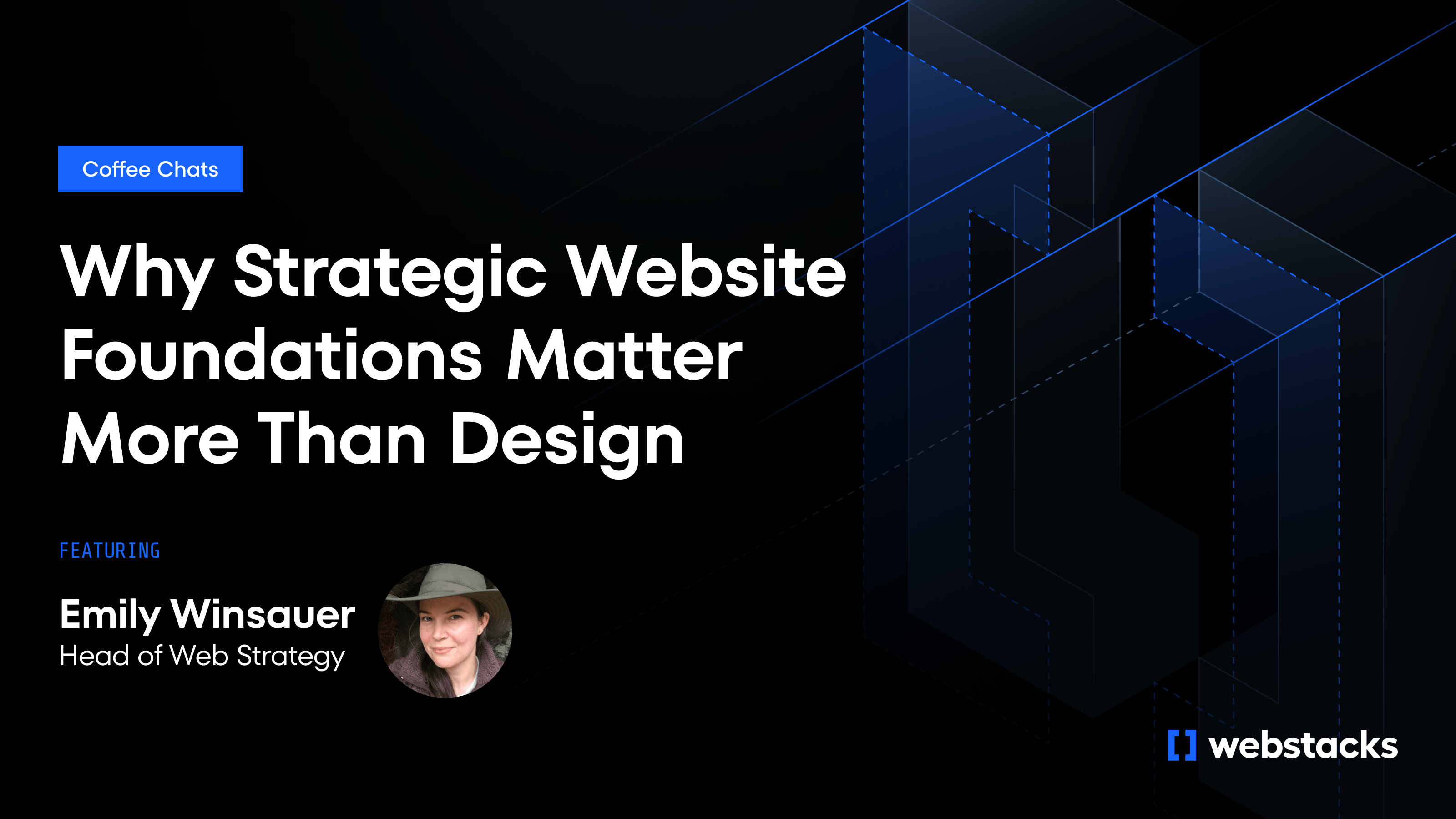Enterprise organizations today rarely operate under a single brand, product, or region. Instead, they manage a constellation of digital properties. This complexity requires a multisite brand implementation.
A multisite brand approach allows companies to manage multiple websites under one system, whether for sub-brands, regions, or product lines.
When done right, it provides brand consistency, operational efficiency, and room for localization and innovation. Done poorly, it leads to bloated CMS platforms, design sprawl, and marketer frustration.
At Webstacks, we’ve helped enterprise teams navigate the complexities of multisite brand rollouts using scalable design systems, flexible CMS architecture, and governance frameworks that return autonomy to marketers. This guide will walk you through our key tips and strategies for executing a successful multisite brand implementation.

1. Align Stakeholders Around a Shared Strategy
Multisite brand implementations don’t fail because of poor tech—they fail because of misalignment. Large enterprises involve multiple teams across marketing, product, IT, and regional leadership. Each has a different view of what the digital experience should look like.
That’s why alignment is the first, and arguably most important, step in any multisite rollout.
Here’s how we do it at Webstacks: we start every engagement with a Web Presence Workshop, an interactive session that brings key stakeholders together to define brand traits, digital priorities, and UX direction.
We use mood boards, competitor audits, and brand exercises to build a shared vocabulary before a single design is created.
This early strategy work ensures that every site, regardless of brand or geography, fits within a scalable digital framework.
It also prevents the downstream friction that occurs when one region veers off-brand or when stakeholders clash over design decisions halfway through the build.
For example, Webstacks client Justworks needed to unify its web presence as it expanded beyond a single product. Their existing site was hard to manage, with design inconsistencies and an overly complex CMS that slowed content updates.
Webstacks helped align marketing, design, and engineering stakeholders early through a shared strategy and embedded team model. The alignment enabled Justworks to roll out new site sections with consistent branding, simplified governance, and a faster go-to-market pace.
2. Define the Right Site Architecture for Your Brand Portfolio
When it comes to implementing multiple websites under a single enterprise umbrella, there’s no one-size-fits-all approach.
The way you structure your digital presence, whether through subdomains, subdirectories, or fully separate microsites, can have a massive impact on SEO, user experience, and team operations.
Start by identifying the core purpose of each site or brand experience. Are you segmenting by region, product, audience, or business line? Does each brand need full independence, or should it share certain elements like design systems, templates, or navigation?
At Webstacks, we use a page prioritization model that breaks your architecture down into three tiers:
- P1 pages are bespoke and critical—think homepage, product, or solution pages.
- P2 pages are assembled from pre-built components with moderate customization.
- P3 pages are templated and often migrated programmatically, including blog archives, legal pages, etc.
This approach lets us map out a scalable architecture and helps determine where a microsite is justified versus when a centralized experience with dynamic personalization is more appropriate.
For instance, if you’re targeting multiple personas (such as SMBs and enterprises) it might make sense to segment those audiences within a single site using strategic content blocks.
But if you’re managing distinct brand identities or product lines (like a parent brand and its acquired startups), microsites with shared infrastructure may provide better clarity and performance.

3. Build a Centralized Design System
As your multisite ecosystem grows, design consistency becomes more important and challenging to manage.
Without a clear system in place, every brand site reinvents buttons and content layouts. The result is design sprawl, inconsistent user experiences, and a CMS that feels impossible to govern.
A centralized, component-based design system solves these problems.
Webstacks specializes in building design systems with atomic components. Think of them as reusable LEGO bricks: each component is visually and functionally flexible, yet designed to fit into the larger system. It enables your teams to create unique brand expressions across sites without compromising consistency.
A design system also simplifies collaboration between departments and geographies. Designers don’t have to start from scratch, marketers can launch campaigns without waiting on developers, and developers can focus on innovation.
For example, Circle needed a more scalable web platform to support rapid growth and new product lines. Their previous site made content updates slow and dependent on engineers.
Webstacks rebuilt the site on HubSpot using a flexible component system. This gave the marketing team the ability to create new pages quickly while keeping the design consistent and the system easy to manage.
4. Use a CMS Built for Multisite Governance
Managing a single site is hard enough. Multiply that by five, ten, or twenty sites across brands and suddenly your CMS becomes either your biggest asset or your greatest liability.
For enterprise teams, a traditional monolithic CMS won’t cut it. You need a system that supports multisite governance: one that allows shared components, centralized design systems, and controlled autonomy for distributed teams.
At Webstacks, we recommend headless CMS platforms such as Contentful, Sanity, or DatoCMS because they’re architected for scale. They allow you to:
- Manage multiple sites from a single instance
- Reuse structured content across brands and regions
- Set role-based permissions for global vs. local contributors
- Localize at the field, page, or component level
- Maintain performance through API-first delivery
With the right CMS, you control branding. Marketers update content independently, developers manage one scalable codebase, and regional teams publish localized experiences without duplicating effort.
5. Standardize Component Functionality
In a multisite environment, branding is only one piece of the puzzle. Just as important is how components behave—how a CTA appears on mobile, what input validations are built into a form, or how content blocks expand or collapse across different use cases.
Many design systems fall short here. They define how things look, but don’t go deep enough into how they function.
The Webstacks team defines functionality expectations during the design phase. Each component, whether it’s a card, hero banner, or testimonial block, is specced with:
- Visual variants (e.g., light/dark mode, background images)
- Functional options (e.g., CTA placement, content slots, animation behavior)
- Editorial controls (e.g., WYSIWYG vs. structured input, character limits)
This level of detail allows for fewer but more powerful components that can be reused across brands and experiences.
It also helps prevent “template fatigue” when every page starts to feel the same because teams are locked into rigid layouts.
6. Empower Regional and Brand Teams
One of the biggest challenges in multisite brand implementation is balancing central governance with local autonomy.
Your core team wants consistency and efficiency, while your regional or brand-specific teams want the freedom to move fast and adapt to their audience.
You don’t have to choose.
With the right systems in place, it’s possible to empower local teams and preserve brand integrity and site performance.
Start by implementing role-based permissions within your CMS. It ensures that central stakeholders can govern design systems and global settings, while regional contributors have access to the specific content they need to manage.
Next, invest in training and documentation. For example, Webstacks provides async onboarding through Loom videos, Slack support, and detailed CMS guides tailored to each user type.
You can also set up editorial workflows, including draft, review, and publish stages, to give brand and content teams more flexibility.
This approach is especially powerful for enterprises with distributed teams across geographies or language markets.
7. Implement Scalable Localization from Day One
If your multisite brand implementation includes international markets, you also need localization.
However, too many organizations treat localization as an afterthought, layering it on late in the project. It creates issues such as duplicated content and mismatched brand experiences.
Instead, think of localization as a core part of your architecture from the start.
At Webstacks, we build CMS setups that support field-level localization. It allows teams to translate only what’s necessary without duplicating entire pages, and keeps your content structure clean.
We also help teams define a scalable localization strategy, including:
- Which content needs translation (vs. adaptation or duplication)
- How to handle currencies, time zones, and regional imagery
- What level of editorial control should regional teams have
- Which languages and regions are part of the initial rollout, and which can be phased in later
For larger organizations, a phased launch approach works best. Start with your primary markets, then expand localization efforts as the system proves itself.
Tip: Check out our guide on localization strategy for SaaS enterprises to see how to approach multilingual site governance
The bottom line is that localization shouldn’t feel like a burden. With the right structure, it becomes a natural part of your multisite growth strategy.

8. Optimize for Performance and SEO at the Architecture Level
When building a multisite digital presence, SEO and performance can’t be bolted on at the end. They must be a part of the architecture from the start.
We recommend Jamstack architectures, typically combining a headless CMS with static site generation using frameworks like Next.js. This setup offers major advantages for enterprise multisite projects:
- Faster page loads through pre-rendered content
- Improved uptime and scalability with CDN-backed delivery
- Cleaner URLs and better crawlability for SEO
- Built-in flexibility for structured data, hreflang tags, and language switching
We also use inventory-style planning documents to define every page, template, layout, and SEO requirement. It maps out metadata, schema markup, and performance considerations before any content goes live.
For example, Snowflake partnered with Webstacks to launch Snowflake University, a dedicated learning hub.
The microsite was built using a modular design system and an architecture that supported fast load times and better discoverability. As a result, organic traffic surged by 900%, making educational content easier to find for learners around the world.
9. Treat Your Website as a Product, Not a Project
Traditional website projects follow a predictable arc: plan, design, build, launch, then wait a few years before doing it all over again. But that approach doesn’t work for enterprise organizations managing dynamic, multisite ecosystems.
Your website isn’t a one-time project. It’s a living, evolving platform that requires continuous iteration and optimization.
At Webstacks, we architect systems with long-term ownership in mind. We empower marketing and content teams to iterate without dev bottlenecks and launch faster with modular components.
We also support parallelized development, where approved components can be implemented while strategy and content for other parts of the site are still in progress. Combined with phased rollouts, this approach ensures enterprise teams can launch key sections early (like Homepage + P1 pages) while the rest follow.
This product mindset supports:
- Ongoing experimentation and A/B testing
- Iterative SEO improvements
- Faster content campaigns and launches
- Easier onboarding of new brands, regions, or products
Think of your site as a digital operating system for your brand. The more flexible, modular, and scalable it is, the more responsive your entire organization becomes.
Start with Strategy and Deliver with Flexibility
A multisite brand strategy requires you to create a scalable system that allows teams to move faster while staying aligned.
From aligning stakeholders to choosing the right CMS, success depends on intentional planning and flexible execution.
Governance doesn’t have to mean rigidity, and localization doesn’t have to mean chaos. With the right foundation, your multisite ecosystem can deliver consistency, speed, and performance across every brand.
At Webstacks, we partner with enterprise teams to bring that vision to life. We don’t just launch sites—we build systems that scale and evolve.
Are you looking to unify and scale your digital presence across multiple brands or regions? Schedule a discovery call to learn how Webstacks can support your multisite implementation.




